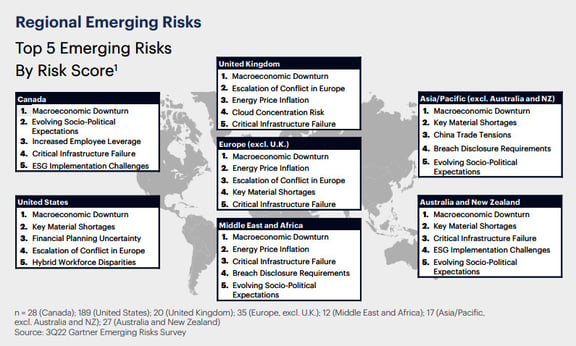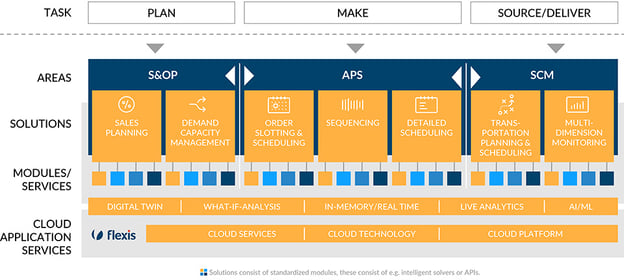7 Easy Ways to Beat Economic Uncertainty with Transportation Logistics
Keith LaBotz - November 25, 2022

Congratulations on weathering two years of supply chain volatility, shortages, lockdowns, and record-high inflation. Is your company prepared for the economic uncertainty ahead?
Gartner’s recent survey on emerging risks suggests senior executives and risk managers are watching macroeconomic problems, material shortages, and energy prices. While monitoring trends is vital for decision-making and forecasts, your company needs a solution for mitigating risks at their source before they impact profitability.

Knowing where to begin can be daunting, given the complexity of the current macroeconomic picture. Starting with a specific economic challenge, like inflation, and exploring its underlying cause can lead to measures that protect your company from broader economic uncertainty.

Inflation is the top concern for 74% of CEOs, and it began getting attention in March 2020 when the US Federal Reserve pursued Quantitative Easing (QE) to stabilize economic damage from lockdowns. Securities purchases expanded the M2 money supply by an astonishing 40 percent, despite widespread warnings of high inflation risk.

For many, the first sign of something wrong appeared when inflation launched in January 2021, skyrocketing to a 40-year high within a few months. With inflation significantly worse than Fed projections since QE began, uncertainty is spreading in business and financial markets.
At the Bundesbank annual symposium a few weeks ago, Dr. Joachim Nagel, Deutsche Bundesbank President, criticized IMF experts and characterized economic prospects as “exceptionally uncertain.” Nagel admitted, “we are seeing our economic models come up against their limits.”
Supply Chains Are Part of a Risky Experiment
Imagine this. Your company wants to evaluate supply chain management software with mixed reviews from much smaller businesses. You will introduce the new software into live production without testing, and there’s no roll-back plan. You’ll just experiment with a little trial and error whenever encountering problems. Everything is going to work out. Trust me; I'm an expert.
If you don't endorse that approach for your supply chain, is there any reason to expect different results if a third party does it? Does it change anything if that party is the Federal Reserve?
The biggest concern is that QE, widely referred to as a monetary experiment, is without historical precedent, and supply chains are its unwitting subjects. The long-term risks from the extreme QE and the ability of central banks to control them are unknown, yet supply chains must deal with the consequences. With the experiment not going according to plan, there's growing concern QE may be a colossal mistake.
Inflation, QE, and USD Reserve Currency: The Trifecta of Supply Chain Uncertainty
Why should QE concern supply chains? QE introduces systemic risks that affect US Dollar (USD) stability and demand volatility. It can also trigger inflation and economic uncertainty, which are particularly unwelcome during a recession.
International trade and energy are denominated in US Dollars, so global supply chains depend on the world’s reserve currency to remain stable. QE impacts global currency and financial markets; it can stabilize or destabilize global markets, economies, and supply chains.
Given the potency of Fed QE, the Fed must maintain control over QE effects, but there's growing uncertainty about that:
- The Fed is struggling to manage the initial impact of inflation.
- The Fed does not know what the long-term effects of QE are - it's waiting to find out.
- There is no precedent for assuring the Fed can manage effects from extreme QE once they materialize.
- If the Fed loses control, there's a risk of runaway volatility. Global financial networks could be overwhelmed like supply chain networks were over the past two years. This would manifest as uncontrolled volatility in supply chains, stopping all shipments.
Prepare for the Unknown
The reasons for uncertainty are clear, and potential risks are more significant than many realize. What can a supply chain do?
If the underlying source of uncertainty is QE, the resolution for supply chains is mitigating currency risks: inflation, deflation, cash flow, and liquidity. These risks translate into cost and volatility problems in a supply chain process, and that's what your solution should focus on.
Here are seven easy steps your company can take to beat economic uncertainty and mitigate potential QE risks in the future.
1. Focus on Transportation Logistics Cost Reductions
Transportation logistics is the best place to start for minimizing costs and volatility. Transportation affects every function in a business enterprise, multiplying benefits and savings with a single change. process improvements and pricing negotiations often produce immediate cost reductions exceeding 20%.
2. Increase Logistics Agility
Over the past two years, supply chain digitization focused on mitigating volatility by increasing operational agility. An agile business process lowers overall risk and costs. The quickest way to attain supply chain agility is to concentrate process improvements on logistics, and these articles can help.
3. Implement Cross-Functional Shipment Planning and Execution
Integrating enterprise business functions can streamline processes, increase efficiency and accuracy, and optimize resources for minimal operating costs.

For example, the flexis suite of apps integrates S&OP, APS, and SCM (logistics) planning and execution to achieve the lowest overall cost.
- Increases Efficiency and Accuracy. Vehicle routing and scheduling ensure delivery trucks drive the fewest miles and minimize fuel consumption and labor.
- Streamlined Processes. Decisions and responses are automated. Unexpected changes could trigger a series of decisions across the board. The human effort required to provide this level of support is enormous.
- Optimizes Resources A combination of actions may result from altering production and shipping plans, modifying forecasts, and rerouting a delivery truck.
4. Optimize Domestic Truck Pricing
Full-truckload (FTL) spot rates dropped 30% since January 2022 and this year, and contract truckload rates decreased by 7%.
- Focus on right-sizing rates from primary carriers with which your company has long-term relationships.
- Re-establish service commitments that slipped during the shipping crunch late last year.
- Review your company’s volume split between internal delivery vehicles, third-party carriers, and truck brokers.
- Utilize spot markets for service gaps to maximize savings in a softer market.
5. Maximize Inbound Freight Savings
Inbound freight represents untapped savings for many companies.
- Review your company’s inbound freight receipts from suppliers for prepaid and add billings.
- Converting these suppliers to collect billing with your company’s inbound freight carriers will reduce freight expenses with these suppliers.
- It might also lead to better discounts on outbound freight if there is sufficient inbound volume.
6. Renegotiate Parcel Rates
-
Consider a parcel advisory firm if your company spends more than $250,000 annually on small-parcel shipping with UPS, DHL, or Fed Ex.
-
An experienced consultant can use historical billing data to identify savings opportunities and guide negotiations for maximum savings.
-
Parcel advisory services work on a gain share model, so your company only pays for the service if there are savings. Typical savings range from 10-20%, and the gain share is negotiable.
7. Maximize Ocean Freight Savings
Ocean rates have fallen dramatically since last year’s shipping crunch. One year ago, the price for a 40-foot container from Asia to Los Angeles was $15,000 per container. Current spot market rates for the same container are $1,275 - ten times less expensive today!
Conclusion
Supply chains are navigating uncharted waters with unprecedented economic uncertainty. Solutions focusing on transportation logistics cost reductions offer immediate relief and protection from macroeconomic risks like inflation, deflation, and recession.
INTERESTED IN MORE INFORMATION?
LATEST POSTS
- Understand Circular Economy in The Manufacturing Industry
- How Can Industry 4.0 IT Integration Be Achieved Smoothly?
- The Significance of Order Sequencing in Discrete Manufacturing
- How to improve your Supply Chain Management: The Power of Control Towers
- Optimizing Human Resource Scheduling in Manufacturing: A Technological Approach



